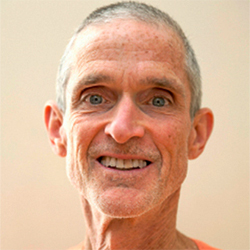Many people I’ve spoken with have experienced moments of striking clarity or deep peace while doing spiritual practices, communing with nature, or during periods of creativity such as painting or playing music. Despite sincere spiritual aspirations, these experiences tend to be few and far between, and they usually take place while in solitude or on a retreat. The idea of feeling centered while at work or while working things out in a relationship seems a remote possibility at best. Even the best intentions and highest philosophies may go out the window in the face of a crisis or confrontation—allowing layers of tension to build up and be carried into the next interaction. Then, when our buttons get pushed, we may “lose it” despite our best efforts to control ourselves.
The best way to develop any muscle is to build it up by repeated use. Developing a steady mind and an inner ease – strong enough to last in the midst of activity—also takes practice.
Even relatively brief sessions, such as 15 minutes twice a day, begin a process of transformation; undoing the conditioned ways of thinking and reacting that we tend to fall into by habit.
During such a meditative practice, we refocus the mind again and again, patiently directing it, training it to remain steadily engaged. As the body relaxes and the mind calms down, we begin to taste the simple joy of being present in the moment. We can start to develop the same ability to focus at work. We will become more aware of the mind’s restless tendency to flit back and forth between thoughts, remaining half preoccupied with worries rather than the task at hand. We can learn to recognize this tendency as the habit of wanting or scheming to secure our happiness as an endless anxiety that things may not go right. When I am struggling so hard to solve the day’s problems, it can be a tremendous relief to realize that it is precisely this tense effort that keeps me from being at ease—from being present with clarity to understand that which needs my attention (not my tension). I discover over and over, that one of the best ways for me to be effective is to keep my own peace no matter what happens around me.
One of the teachings from Raja Yoga that especially supports this effort is the idea of responding with friendliness to friendly behavior, and with compassion to sorrowful behavior, with delight to virtuous behavior, and with detachment to harmful behavior.1 It has probably happened to all of us that after someone has acted unreasonably, angry or obnoxious towards us, we find out later how much pain they were in. We may not be able to help them. I know I have benefited so much from not taking such behavior personally, and waiting for a calmer moment, if possible, to interact with them. We can never expect to control the moods of others, but we can value our own balance, knowing it is the only way we can hope to respond constructively.
The way we practice Hatha Yoga can be a great analogy for how this can work. In all our efforts, there should be an element of relaxation that allows us to stretch further. I have often seen in my service the importance of distinguishing between healthy pain, that comes from stretching carefully, and that strain that comes from forcing too much, causing me to get sick or to hurt someone else. During stressful situations, we can re-center ourselves by consciously focusing our minds on the focal point we have used regularly in our meditative practice. By inwardly repeating a mantra or prayer, or by calming and watching the breath, we draw on the powerful association our practice has cultivated, which helps us slow down. Returning to the present, we call forth our connection to the spiritual consciousness inside that remains undisturbed. If we can remain even a little connected to that consciousness, where we can experience our natural completeness, our self-esteem is not so dependent on being right, and we are more capable of accepting criticism or standing our ground in the face of adversity. It is a true sign of inner strength to be able to express ourselves with conviction and be open-minded to the suggestions of others, but not sidetracked by their personalities.
It can also be helpful to understand that the challenging circumstances we face may be exactly what’s needed to draw forth new strengths from us, to teach us where our weak spots are, and to bring attention to what in us needs healing. Fortunately, most of us seem to have ample opportunities to experiment and learn from this universe-ity.
Swami Ramananda is the President of the Integral Yoga Institute in San Francisco and a greatly respected senior teacher in the Integral Yoga tradition, who has been practicing Yoga for over 35 years. Ramananda offers practical methods of integrating the timeless teachings and practices of yoga into daily life, and transforming the painful aspects of human experience into steps toward realizing one’s full potential.
He leads beginner, intermediate and advanced level yoga teacher training programs in San Francisco, and offers a variety of programs in many locations in the U. S., Europe and South America. Ramananda trains Yoga teachers to bring Yoga into corporate, hospital and medical settings and has taught mind/body wellness programs in many locations. He is a founding board member of the Yoga Alliance, a national registry that supports and promotes yoga teachers as professionals. His warmth, wisdom and sense of humor have endeared him to many.
(by Swami Ramananda, from the May, 2005, IYTA Newsletter)

